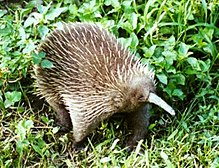| Long-beaked echidnas[1] | |
|---|---|

| |
| Western long-beaked echidna (Zaglossus bruijni) | |
| Scientific classification | |
| Domain: | Eukaryota |
| Kingdom: | Animalia |
| Phylum: | Chordata |
| Class: | Mammalia |
| Order: | Monotremata |
| Family: | Tachyglossidae |
| Genus: | Zaglossus Gill, 1877 |
| Type species | |
| Tachyglossus bruijni | |
| Species | |
| Synonyms | |
| |
The long-beaked echidnas (genus Zaglossus) make up one of the two extant genera of echidnas: there are three extant species, all living in New Guinea.[2][3] They are medium-sized, solitary mammals covered with coarse hair and spines made of keratin. They have short, strong limbs with large claws, and are powerful diggers. They forage in leaf litter on the forest floor, eating earthworms and insects.
The species are
- Western long-beaked echidna (Z. bruijni), of the highland forests;
- Attenborough's long-beaked echidna (Z. attenboroughi), discovered by Western science in 1961 (described in 1998) and preferring a still higher habitat;
- Eastern long-beaked echidna (Z. bartoni), of which four distinct subspecies have been identified.
The Eastern species is listed as vulnerable, while the Attenborough's and western long-beaked echidna species are listed as Critically Endangered by the IUCN.[4][5][6]
- ^ Groves, C.P. (2005). "Order Monotremata". In Wilson, D.E.; Reeder, D.M (eds.). Mammal Species of the World: A Taxonomic and Geographic Reference (3rd ed.). Johns Hopkins University Press. pp. 1–2. ISBN 978-0-8018-8221-0. OCLC 62265494.
- ^ Werneburg, I.; Sánchez-Villagra, M. R. (January 2011). "The early development of the echidna, Tachyglossus aculeatus (Mammalia: Monotremata), and patterns of mammalian development". Acta Zoologica. 92: 75–88. doi:10.1111/j.1463-6395.2009.00447.x.
- ^ Flannery, Timothy F.; Rich, Thomas H.; Vickers-Rich, Patricia; Ziegler, Tim; Veatch, E. Grace; Helgen, Kristofer M. (2022). "A review of monotreme (Monotremata) evolution". Alcheringa: An Australasian Journal of Palaeontology. 46 (1): 3–20. Bibcode:2022Alch...46....3F. doi:10.1080/03115518.2022.2025900. S2CID 247542433.
- ^ Cite error: The named reference
IUCN_David'swas invoked but never defined (see the help page). - ^ Cite error: The named reference
IUCN_Easternwas invoked but never defined (see the help page). - ^ Cite error: The named reference
IUCN_Westernwas invoked but never defined (see the help page).